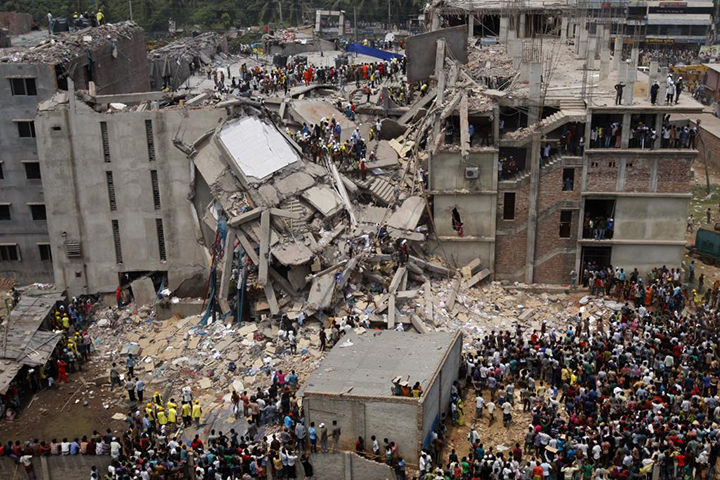Why Transparency in Fashion Matters
What’s the environmental impact of your closet?
What’s the environmental impact of your closet?
When you think about greenhouse gas (GHG) emissions, you probably think about smokestacks, tailpipes and forest fires before you think about t-shirts, right?

But consider this: Americans bought 60 per cent more clothing in 2014 than in 2000. If consumption rates continue on this trajectory, the world will need three times as many resources in 2050 to meet demand. For a resource-intense industry, that’s a big deal.
- Eight per cent of the world’s GHG emissions is created by the apparel and footwear industries. That’s about the same percentage as the whole European Union.
- It can take 2,700 litres of water to produce one cotton t-shirt—the same as one person’s drinking water for two-and-a-half years.
- Cotton—which covers 2.4 per cent of the world’s cultivated land—uses six per cent of pesticides and 16 per cent of insecticides.
- Beyond environmental issues, the garment industry is famous for low wages and worker abuse. In fact, garments are the second highest at-risk product category for modern slavery.
A Fashion Revolution
On April 24, 2013, a building known as Rana Plaza collapsed in Bangladesh, killing 1,134 people and injuring 2,500 more. Most were garment workers forced to return to the building despite large cracks in the walls.

Fashion Revolution formed in the wake of this disaster. Both an organization and a global movement, it aims to change “the way our clothes are sourced, produced and consumed.” Every April, it holds Fashion Revolution Week and the #whomademyclothes campaign, a call for consumers to ask for more transparency from their favourite brands.
While there are many statistics that show how dangerous the garment industry is, both for people and the planet, one of the biggest challenges is that brands don’t know their own supply chains. In their Fashion Transparency Index 2018, Fashion Revolution reviewed 150 of the biggest global fashion brands and ranked them “according to how much they disclose about their social and environmental policies, practices and impact.” The brands were rated based on publicly available information and data.
Adidas and Reebok came out on top, with a disclosure level of 58 per cent each. Below them, luxury and bargain brands were interspersed, showing that paying more for a product doesn’t necessarily mean greater transparency or sustainability: Zara is at 42 per cent; Prada and American Eagle both sit at 15 per cent; Chanel is at 3 per cent.
Why Is Transparency Important?
You cannot monitor your supply chain if you don’t even know where your manufacturing facilities are. When Rana Plaza collapsed, people picked through the rubble to find clothing labels that would tell them which brands’ clothes were made there. Brands can use this to evade responsibility—they had a contract with a reputable factory! How could they know that factory would subcontract it?
As Christina Hajagos-Clausen, garment director at IndustriALL Global Union, writes in the Fashion Transparency Index 2018, “Transparency of a company’s manufacturing supply chain better enables a company to identify and assess actual or potential adverse human rights impacts.”

Nazma Akter, Bangladeshi trade unionist and founder of the AWAJ Foundation, adds, “If unions and workers in Bangladesh have a list of where brands are manufacturing, it is so much easier for us to resolve problems quickly. We don’t need to do big public campaigns; we can address issues directly with brands.”
The good news is that improvements are being made. Voluntary sustainability standards, such as the Ethical Trading Initiative, help brands become more transparent. For example, the Better Cotton Initiative works with cotton farmers to make their crops more sustainable, and Cradle to Cradle assesses the impact a product has on the environment, both in its initial production and in its recyclability.
Though greenwashing is prevalent, retailers are facing increased pressure from their customers for more sustainable options. Fashion Revolution Week gets people to ask all at once: who made my clothes?
Further reading
Blog: Do Voluntary Standards Actually Stop Biodiversity Loss?
Blog: How Can Sustainability Standards Contribute to Empowering Women’s Food Security?
Blog: Should Farmers Who Follow Sustainable Practices Be Rewarded?
You might also be interested in
IISD Annual Report 2023–2024
While IISD's reputation as a convenor, a trusted thought leader, and a go-to source on key issues within the sustainable development field is stronger than ever, the work happening outside the spotlight is just as valuable.
Border Carbon Adjustment Mechanisms and Impacts on Vietnam
This report consolidates, analyzes, and presents views and perspectives of stakeholders from Vietnam on border carbon adjustment (BCA) schemes to contribute to the global debate on BCA good practices.
The triple-COP year: what it means for nature
In 2024, the Rio Conventions on biodiversity, climate change, and desertification will have their negotiations in the same year. We take a look at the implications for nature.
Effectively Delivering on Climate and Nature: NDCs, NAPs and NBSAPs Synergies
This checklist for national policy-makers illustrates potential opportunities and interactions during the development or update of the nationally determined contribution (NDC), National Adaptation Plan (NAP), and national biodiversity strategies and action plan (NBSAP).
